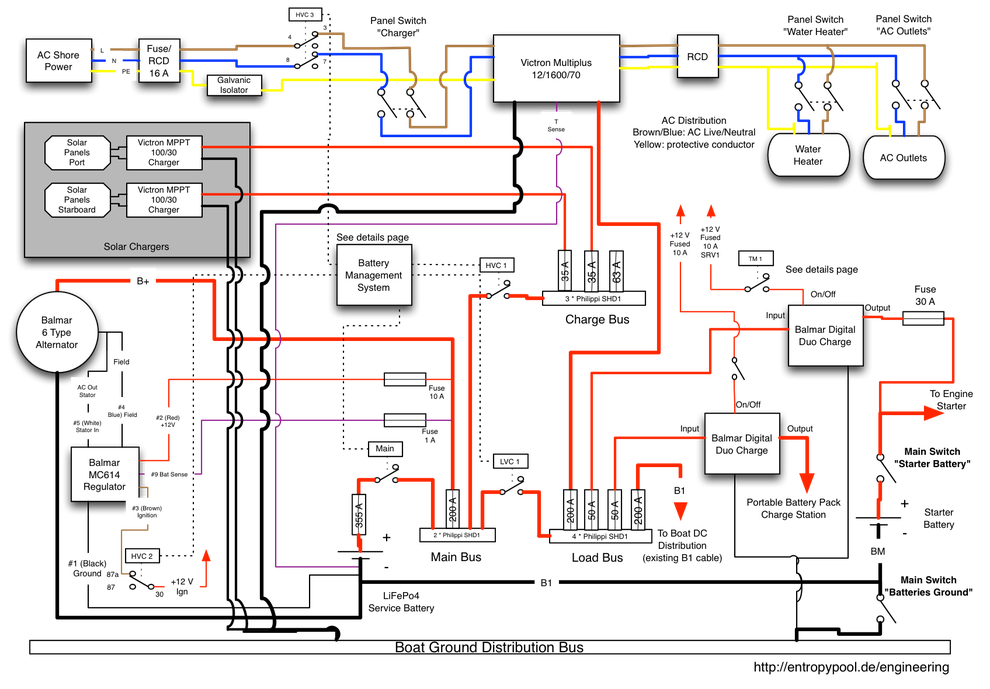Engineering
Engineering · 15.04.2021
This is an effort to reverse engineer the characteristics of the House Power BMS Cell Modules and
create an independent but compatible OpenSource replacement firmware which emulates the original firmware's behavior in a way that the original House Power BMS main module can still be used.
Engineering · 01.10.2016
2019-05-12 Update: Fixed typo in "logic table" 2019-04-05 Update: Fixed an error in the schematics: Q2, Q3 should be "B" type. The previous version had C and E swapped on Q2 (fixed in the version below). 2016-10-08 Update: Modified schematics to include additional MOSFET protection components (D3 - D6). Thanks to Eric (OceanSeaSpray) from nordkyndesign.com for pointing this out. This post describes an electronic circuit which can be used to drive latching (bi-stable) relays from a controlling...
Engineering · 31.10.2015
As previously described, we intended to replace the old alternator with a high performance model which can withstand extended periods of high loads (the LiFePO4 bank will absorb any current you throw at it, overloading most standard alternators quickly) and also produces as much energy as possible to allow us recharging our battery quickly. After some research and excellent consulting from Richard (RJS Marine) we decided to try the Balmar AT165 alternator (the red component), a very nice design...
Engineering · 05.08.2015
The 16 individual Winston 100 Ah cells will have to be arranged and fixed in the form of a battery block in order to prevent unwanted movement during passage or worse in case of capsizing. This image was taken during a dry run for checking the available space in the battery compartment before the necessary parts were ordered. Requirements: physically constrain movement of the cells, prevent battery pack from unwanted movement in rough seas, and also prevent block from falling apart if capsizing...
Engineering · 25.06.2015
Our first trip with out new boat was totally exciting. We took her out to a two week vacation on the Balearic Islands. Apart from just enjoying our first trip on our new boat one of the primary goals was to measure our energy consumption when at anchor and during passage. In order to get accurate numbers, we had to simulate the real world scenarios, and that meant leaving the fridge unit on all the time (during measurement) and also running all instruments, lights and autopilot when cruising....
Engineering · 04.06.2015
When designing the electrical system for Entropy it became clear that we need a backup BMS module in case the main installation fails. In addition we were interested in avoiding the traditional gasoline driven outboard for our dinghy. The decision was taken quickly: let's go electrical! To run an electric outboard one needs a compact, portable power source. The ideas was born to use roughly the same design as in the main battery bank and build a mini version in a rugged, waterproof case. You...
Engineering · 18.05.2015
2016-06-30 Update: As Jim pointed out in the comments - and which was meanwhile confirmed by Balmar support - the Digital Duo is not a DC/DC charger, it is rather a switching device which will not step up voltage and hence lead to undercharging the starter battery. This device was replaced by a Sterling Pro Charge B BBW 1212 (more or less a drop-in-replacement). 2019-12-13 Update: Today I would choose the smallest Victron "Orion-Tr Smart DC-DC Charger Isolated" charger. Advantages: much smaller...
Engineering · 16.05.2015
Although LiFePO4 batteries are quite forgiving in most normal operating conditions, they are very sensitive to overcharging and over-discharging. Even one single mistreatment can damage the cells permanently, reducing capacity significantly or even destroying them. In order to prevent damage to the cells, a protective device is needed that permanently monitors the cells and takes action if dangerous operating conditions are detected. Possible actions range from alarms to shutting off charging...
Engineering · 15.05.2015
The core of our future energy management solution will be the service battery bank, of course. After some research I found that the Chinese company Winston was producing batteries well suited for boating purposes. The battery chemistry of Winston cells has been improved by adding Yttrium to the mix. This results in an increased life time of the cells and also improves resiliency against low temperatures. While traditional LiFePO4 cells may not be used (charged or discharged) below 0 °C, this...
Engineering · 04.05.2015
Most sailing boats come with two standard charging sources for their batteries: shore power charger alternator Our boat was no different, the Yanmar engine was equipped with a standard Hitachi 80 A alternator (see picture), and for charging in the marina two 40 A Cristec chargers connected in parallel to charge both starter and service batteries. A classic "no frills" setup, that is. The stock alternator was internally regulated and had no over temperature protection (as far as we could find...










